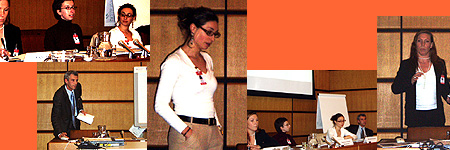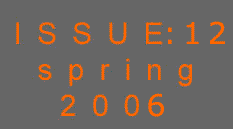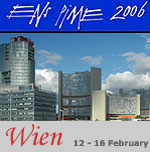
PIME 2006: ENS/Young Generation Nuclear (YGN) Report
During PIME 2006, which took
place in Vienna, from 12-16 February, the ENS YGN group organised
and moderated a workshop conference dedicated to the subject of
how to communicate effectively to the next generation on the sensitive
issue of waste management. The workshop theme was chosen because
the issue of radioactive waste generated by nuclear power plants
remains a major obstacle to furthering the cause of nuclear new
build in Europe. Five speakers gave interesting presentations
on the subject. The themes discussed included an analysis of how
local partnerships can help encourage the active participation
of key stakeholders, initiatives aimed at involving schools to
promote increased knowledge of the subject among young people
of various ages, a review of how young people can contribute to
a national debate on waste management, country-specific perspectives
and a consideration of what the industry should do to promote
its actions and record when it comes to waste management. Here
is a YGN network summary of what happened at the workshop:

The workshop started with Fanny Bazille, Head
of Communications at the CEA’s) Nuclear Energy Division.
In her presentation, which was titled ‘Why don’t young
people mind energy?’ Fanny gave an overview of how young
people have participated actively in the recent national debate
on nuclear waste management in France. She reported that young
people were very reluctant to participate in debates on a topic
that was both scientific and political as these are areas which
the younger generation do not like to engage in that much.
The national debate in France has highlighted
a key issue – which is that the young generation is unlikely
to participate in a debate where they feel that its viewpoint
has no impact on the final decision and where participants act
more like consumers or stakeholders than citizens. Fanny stated
that personal responsibility and greatercitizenship is required
if there is to be greater participation in important public debates.
Sini Gahmberg, Press Officer at TVO’s Olkiluoto
plant, then gave a presentation on TVO’s collaborative work
with local schools. She described the progressive educational
programme that has been put in pace to offer to local school children
aged between 13 – 16 years old the opportunity to learn
more about nuclear energy. The programme has a strong practical
element to support the theoretical teaching content, which enables
students to play an active role in the learning process. Excursions
were advocated as an essential part f the programme, with TVO
members setting students homework assignments on their visits
to nuclear facilities.
|
This collaboration, which involves schools located within a
50 km radius of the Olkiluoto site, has further developed,
with TVO now also organising science and technology camps
for students. These camps have been strongly supported by
the parents. Overall, Sini’s presentation provided
a very positive example for industrial companies to consider
adopting and implementing. |
Miranda Kirschel, Corporate Affairs Officer at
Nuclear Industry Association in the UK then spoke to delegates
about specific communications problems with regard to radioactive
waste that the UK has experienced and their impact upon the British
public’s perception of the new-build option. In her presentation,
which was entitled “No time to waste,” Miranda underlined
that the UK public considers the nuclear waste issue to be the
greatest “disadvantage” of nuclear energy (57% of
those questioned quoted radioactive waste as the most negative
thing about nuclear energy). Various lessons have been learnt
from previous public consultation processes and Miranda advocated
informed and responsive behaviour and emphasis on the industry’s
pride in its competence record constructive as ways of supporting
communications on waste management. It was also emphasised how
YGN is an important part of the waste communication matrix, with
members networking with young politicians, coaching experts in
effective communications and actively participating in nuclear
debates.
Kajsa Engholm, of SKB, began her presentation
by focussing on how the nuclear industry should communicate more
with children and teenagers, as they represent the future. Like
Sini Gahmberg, Kajsa too advocated strong collaboration between
industry and local schools as the key to communicating more effectively
with the younger generation and securing a better understanding
of nuclear energy in the future. Among the initiatives that she
suggested were creating an interactive website with a simple navigation
format where young people can find information in a simple, easily-accessible
and entertaining way. An interactive approach is essential to
inform the next generation on nuclear waste and to encourage active
learning on the subject.

Kajsa went on to outline SKB’s activities
in this area. All costs associated with school children’s
visits are met by SKB, which helps with school budgets and organises
site visits. Prior to the visit a resource pack is issued to teachers
to enable them to inform their classes about the forthcoming visit.
Following the visit, a “teachers’ newsletter”
is published and sent to teachers four times a year. This type
of follow-up activity is extremely important as it keeps interest
in SKB - and therefore the industry - alive and provides an update
of how SKB’s activities are progressing.
The final presentation of the workshop was entitled
“Local partnerships: A way to achieve a sustainable solution
for LILW.” It was given by Laurent Wouters, and E. Hooft,
of ONDRAF/NIRAS (Belgium’s national organisation responsible
for managing radioactive waste and fissile materials). ONDRAS/NIRAF
took the brave decision to involve stakeholders from the very
beginning in a decision-making process that aimed to identify
a solution for final LILW waste disposal. An open and transparent
process based on close co-operation was developed to enable stakeholders
to decide together on options for the long-term management of
radioactive waste. Three municipalities with nuclear facilities
on their territory created local partnerships, each supported
by an annual budget, which enabled stakeholders to work independently
to identify possible solutions. Ground-level communication was
the key to successful cooperation, with concept designers liaising
directly with local stakeholders and reworking the initial concept
or proposal based on their discussions.
Laurent stressed that the main strength of such
a collaborative and inclusive approach was that it encouraged
a mutual decision-making process between stakeholders and the
waste management organisations. It also enabled concept designers
to gain a greater understanding of what local inhabitants expect
a waste disposal project to bring to the local community. In essence,
this approach places a project for the location of a waste repository
within the social and cultural context of a specific area, which
can only help the right long-term waste management decisions to
be taken.
In conclusion, delegates who attended the YGN
workshop on waste management were able to clearly recognise that
waste management issues will continue to fundamentally affect
the public’s perception of nuclear energy as a whole, and
both conventional and innovative communication strategies will
need to be adopted if greater awareness and understanding of the
issue is to be achieved.
|








